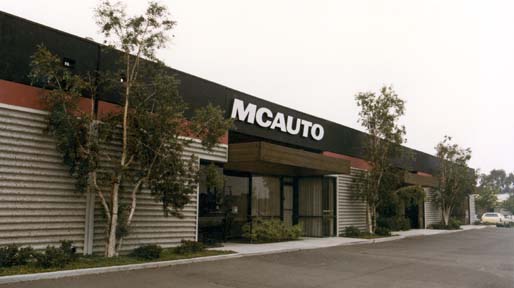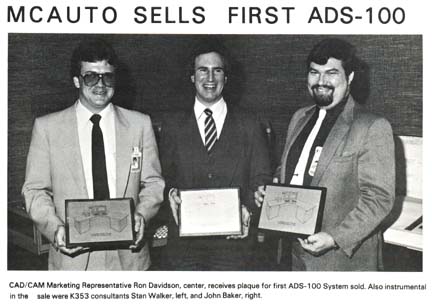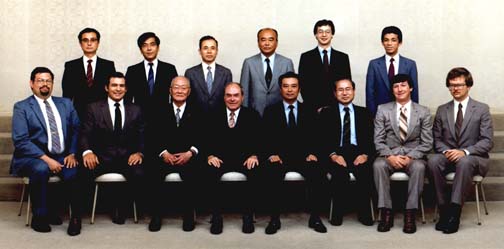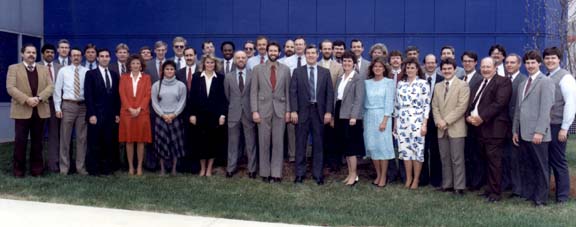The Unigraphics development staff moved from their Carson facility into four buildings in an industrial park at 5552 Cerritos Avenue in Cypress, CA. Based on the standard MDC facility naming convention this site was forever to be known as the "K-17 Facility". Visitors to this facility were always amazed that it was in the middle of a strawberry field and many of them would snatch fresh berries if they were fortunate enough to be there during harvesting time. Below is a picture of the main building at this site.April, 1980:
Also during February, the 4th annual Unigraphics Users Group Meeting was held, again at the South Coast Plaza Hotel in Costa Mesa, CA. Over 100 people attended including several senior executives from McAuto. One of the significant features of this years meeting was that this was the first time that separate groups met to discuss topics of special interest such as NC programming, drafting, etc.. This was the beginning of what later become known as the SIG (Special Interest Group) sessions.
The first DEC Special Interest Group meeting was hosted by McDonnell Douglas Astronautics Company in St. Louis, MO. There were 18 people from 9 companies in attendance, however, there was no official participation by McAuto.May, 1980:
Unigraphics is implemented on Data General systems running the AOS operating system. In the same sense as the DEC PDP implementation, this allowed the software to run on the native operating system without the need for the proprietary TSS system. From here on out, except for support of legacy systems, Unigraphics was always to run on the hardware vendors native OS.August, 1980:
September, 1980: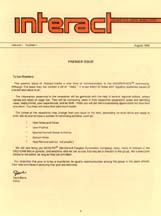
The Unigraphics Users Group publishes the first issue of their new newsletter the "Interact". The first editor was Dave Berry from Harris Corporation, Dayton, OH. In addition to reporting on the success of the spring Users Group Meeting there were columns on user hints, the GRIP Library and the announcement of the election of officers of the Unigraphics Users Group. The officers included:The cover of Volume 1, Number 1 of the "Interact" is shown at the right. For a complete version of this and other early issues, please visit the "Archive".
- Chairman Tom Meagher, Caterpillar
- Vice-Chairman Don Leake, Harris Corporation
- Secretary/Treasurer Christ Tayon, Valeron
McAuto releases Version D2 of Unigraphics. This version included many major enhancements, some of them listed below:October, 1980:Generally speaking, D2 was the first version of Unigraphics that can be considered as supporting true 3D modeling. Up until then, while it was possible to create 3D models (the Unigraphics data base had always supported 3D objects) it was difficult at best and many of the functions and applications either did not support 3D or did not take full advantage of 3D data when it was present.
- Cubic Spline (replaced Spline Under Tension)
- Sculptured Surfaces (Gordon Surface)
- View-Independent Construction via the WCS (Work Coordinate System)
- 3D Transformations
- Finite Element Module (GFEM)
- Multi-Axis Machining Module (GMAX)
Also during September, the first European Users Meeting was held in Surrey, England. Representatives from 12 European Unigraphics customer were in attendance.
The second issue, Volume 1, Number 2, of "Interact" was published. The main topic was the Data General AOS operating system with comments submitted by several customers.November, 1980:
The second DEC Special Interest Group meeting was hosted by Avco Lycoming and was held in Stratford, CT. This was the first of these meeting where there were presentations made by McAuto personnel.December, 1980:
The third issue, Volume 1, Number 3, of "Interact" was published. The main topics in this issue included articles about some early use of Unigraphics at colleges and universities as well as the first suggested standards for submitting programs to the GRIP Library.February, 1981:
May, 1981: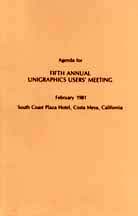
Version D2.1 of Unigraphics was released. This was primarily a maintenance release however it did include support for the DEC VAX system running under VMS. This is the first time Unigraphics was offered on 32-bit computers. Note that Unigraphics was still based on a 16-bit data model, but was modified so that it would run on the VAX. McAuto also announced that they intended to port Unigraphics to the just announced Data General 32-bit systems as well. Note that this also was the first of the so-called "point" releases of Unigraphics. From here on out, all major enhancements releases of Unigraphics would carry an integer designation while maintenance releases would be designated by a decimal point label.Volume 2, Number 1 of the "Interact" is published. It was released in conjunction with the 5th Annual Unigraphics Users Group Meeting held at the South Coast Plaza Hotel in Costa Mesa, CA. There were over 120 people in attendance. Note that at this meeting the formal proposal to form SIG's (Special Interest Groups) was put forward and approved by the attendees. It was decided that at the 1982 meeting that an entire day would be set aside for separate meetings of individual SIG's. Shown at the right is the cover of the agenda from that meeting. To get a better look at this and other meeting agendas, please visit the "Archives".
Volume 2, Number 2 of the "Interact" is published. This issue highlighted several customer success stories.June, 1981:
The 3rd DEC Special Interest Group Meeting was held at Lehigh University in Bethlehem, PA. Note that these meetings were intended for Unigraphics customers who were using DEC (both PDP and VAX) hardware. In addition to presentations by users and McAuto personnel, representatives from DEC also demoed new hardware and made presentations about how CAD, and Unigraphics in particular, was being used at DEC. Note that years later this series of meetings eventually evolved into the Unigraphics Fall Workshops.August, 1981:
Volume 2, Number 3 of the "Interact" is published. This issue reported the details from the February Users Meeting as well as discussing the proposed enhancements in the next version of Unigraphics (D2.2).September, 1981:
McAuto releases Version D2.2 of Unigraphics. This version included many major enhancements, some of them listed below:October, 1981:The 2nd Annual European Unigraphics Users Meeting was held in Woking, England.
- New editing functions for dimensions and drafting entities
- User-definable character fonts
- New methods for creating conic section curves (loft conics)
- New surface/surface integration algorithm
- Major enhancements to the machining modules
- Support for the Data General MV8000 32-bit system
November, 1981:
Volume 2, Number 4 of the "Interact" is published. This issue reported the details from the DEC Special Interest Group Meeting (which had been held in June at Lehigh University).
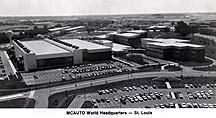
In St. Louis, MO, John Clancy (shown at right) is promoted to Vice President and takes over responsibility for all CAD/CAM operations at McAuto. George Meister continues as the head of the Unigraphics development and support organization in Cypress. At about this same time, the St. Louis Unigraphics staff are moved into the McAuto world headquarters building (shown on the left) and this, along with John Clancy's promotion, establishes St. Louis as the official headquarters for the rapidly growing world-wide Unigraphics operation.
McAuto introduces the new raster based systems, the ADS-100 and DDS-100 at AutoFact in Detroit, MI.December, 1981:The ADS-100 (Autonomous Design Station) was particularly significant since it was the first fully functional CAD/CAM system that cost less then $100,000 (this was in 1981 dollars). Remember, up until this time all CAD systems were based on having one or more design stations hooked to a central CPU. Because of the cost of these large CPU's it was difficult for small to medium sized companies to purchase a CAD system. What made the ADS-100 different was that it was a stand-alone system (you could say it was the first CAD "workstation"). You got a CPU, a display sub-system, central storage, even the furniture and a really comfortable chair along with a single license of Unigraphics (and remember, back in those days there weren't any sub-modules so you got a full CAD/CAM system). The DDS-100 (Dependent Design Station) were like the older Tektronix terminals in that they were connected to a central CPU. Shown at the right is a fully configured ADS-100 (compare this to today's desktop workstation or even your laptop). Note that the plotter and paper tape punch/reader were extra cost items.
Volume 2, Number 5 of the "Interact" is published. This issue included a couple of articles from customers and also reviewed the proposed agenda of the upcoming 1982 Users Meeting.February, 1982:Note that this issue of "Interact" will be the last one highlighted in this section. For a review of the remainder of the issues of the "Interact", please see the "Archives".
The 6th Annual Unigraphics Users Meeting was held at the South Coast Plaza Hotel in Costa Mesa, CA. This was the first meeting using the new 4 day format with the extra day set aside for newly formed Special Interest Groups (SIG's). At this meeting the following SIG's had special sessions:March, 1982:Also demonstrated at this meeting were the new raster-based display systems, the ADS-100 and DDS-100 (for a more complete review of this new hardware, please visit our "Hall of Hardware").
- Training
- NC
- DEC Based Systems
- DG Based Systems
- Design/Drafting
- System Management
- New Technology
McAuto sells its first ADS-100 system to Rehrig Pacific Company in Los Angles, CA. Rehrig Pacific used it to design plastic crates used by the beverage and dairy industries. Shown below is the McAuto team that was responsible for that first sale.
McAuto begins demonstrating the first interactive Solid Modeling system. This was a special prototype product based on PADL (Part and Assembly Description Language) developed at the University of Rochester, in Rochester, NY. PADL, as the name implies, is actually a language based system and was created in order to demonstrate the possible application of Solid Modeling in industry. This first version, PADL-1, was a very simple system using the CSG (Constructive Solid Geometry) approach to creating 3D models.April, 1982:The primary method of construction was to create primitives and then to combine them together using Boolean operations, however this first system only supported 2 primitives, Blocks and Cylinders. The user was further limited by the fact that these objects could only be oriented along the X, Y or Z axis of a single fixed frame of reference. While this may seem to be very archaic compared to today's systems, at the time it represented the leading edge of modeling technology.
This "demonstration" system that the Unigraphics group developed was never sold nor was it ever installed at any customer sites. It ran on the DEC VAX system and used a normal Tektronix 4014 terminal for displaying the final models. The system used a series of menus that prompted the user for object type, size and location. Then the user described which booleans to perform and in what order and then how to display the results. Note that this system was used in several sales situations where it was important to show where McAuto thought the direction of the technology was going. And in at least one case, it was used in an actual benchmark. To see more examples of models that you could create in PADL-1, please visit the "Art Gallery".
McAuto releases Version D3.0 of Unigraphics. Note that while this was a very significant release, there was very little actual new functionality. The significance of this release was the fact that this was the first version of Unigraphics to support the new raster display technology (ADS-100 and DDS-100) including for the first time, color entities (there was support for only 7 colors back then, but up until that time, there had only been support for one color, GREEN). What enhancements there were were mostly limited to the changes made to support the new displays, such as editing the color of an object, erasure of deleted/blanked objects without having to do a display repaint, dynamic display control, etc.June, 1982:Note that D3.0 still provided full support for the old Tektronix displays and even allowed customers to mix the different display technologies on the same CPU all running the same version of Unigraphics (note the Unigraphics provided full support of the older style "green screen" storage tube terminals until the release of Unigraphics II).
The 4th DEC Special Interest Group Meeting was held at Los Alamos National Labs in Los Alamos, NM. Approximately 35 people were in attendance and there were presentations by both McAuto and DEC as well as by personnel from the laboratory.July, 1982:
In a meeting on the Queen Mary in Long Beach, CA, Tom Rafferty and his senior technical leaders (known collectively as "Snow White and the Seven Dwarves") met to discuss the need for a major re-engineering of Unigraphics. This and other meetings held over the next month or so culminated in the launching of a major development project which eventually resulted in the release of Unigraphics II. And exactly who were the Seven Dwarves? As stated, these were a group of senior development leaders and included:September, 1982:Note that all of the "Dwarves", with the exception of Gary Newell who passed away spring 2000, are still with the Unigraphics organization.George Allen Chuck Grindstaff Vic Hambridge Chris Mehling Gary Newell Paul Sicking Wil Valenzuela
McAuto announces Version D4.0 of Unigraphics at the 1982 International Machine Tool Show (IMTS) in Chicago, IL. Some of the new functionality delivered with Version D4.0 included:November, 1982:Also introduced was McAuto's new Robotic off-line programming system, Place.
- GRIP NC
- IGES
- UG-Net (supported asynchronous file transfer between DEC and DG systems)
- Support for HP Pen Plotters
- Analytic Surfaces
- 3D Mass Properties
- Shell Mesh Generation in GFEM
About this time, McAuto decided to change the names of its display stations, shortening them to the A-100 and D-100.
McAuto announces the world's first truly interactive commercial Solid Modeling system, UniSolids, at Autofact 4 in Philadelphia, PA. The highlight of the show was a live demonstration where a model of the Liberty Bell was designed with UniSolids, passed to Unigraphics where a tool path was created using GRIP NC, post processed and then transferred to a 3-axis milling machine via McAuto's DNC system. There a robot (programmed with the Place software) placed blocks of foam board into an automatic fixture on the milling machine where they were machined with the shape of the Liberty Bell (including the crack) and then the robot removed the finished blocks and inserted them in a box, closed the cover and delivered the completed package to the McAuto presenter where he presented it to someone in the large crowd of people watching the demonstration, which was repeated once every hour.February, 1983:Also announced at Autofact 4 was the signing of the first Unigraphics distributors agreement in Japan. This agreement with Daini-Seikosha, Ltd (SEIKO), included both an agreement to resell Unigraphics in Japan as well as a license to use Unigraphics for designing and manufacturing SEIKO products. Pictured below are members of the joint Seiko-McAuto team that negotiated the agreement in Japan.
McAuto starts shipping Version D4.0 of Unigraphics.May, 1983:The 7th Annual Unigraphics Users Meeting was held in Costa Mesa, CA. In those days Monday was split into two separate sessions, one for DEC users and one for Data General users (in fact there was quite a rivalry between the two groups as to who had the best sessions as both DEC and DG were also users of Unigraphics). At this meeting Data General announced the MV10000, the most powerful 32-bit system available that supported Unigraphics. Specifications included up to 18 GB of disk storage and a maximum of 16 MB main memory. McAuto estimated that 12-14 Unigraphics terminals could be hooked to a single MV10000.
Unigraphics Version D4.1 is released. In addition to bug fixes, there were several significant enhancements including:June, 1983:Also, Version D4.1 was the first release where the VAX and MV versions took full advantage of the 32-bit architecture including support for virtual memory and the elimination of multiple coreloads. This resulted in a tremendous improvement in performance on the 32-bit systems and actually was based on work that was being done on the yet-to-be-released Unigraphics II.
- Offset Surfaces
- Fillet Surfaces
- Interface to Moldflow
- UG-Net updated to support DECNet and DG Xodiac
- PLUSER introduced (toolkit for custom built plot drivers)
Note that this was the last release full release of Unigraphics before the introduction of Unigraphics II and while there was a Version D5.0 and D6.0, these were essentially only maintenance releases and were provided primarily for those customers who were still on 16-bit DEC and Data General systems.
Version 1.0 of UniSolids is delivered to the first customers.
This release of UniSolids was only offered on 32-bit DEC VAX systems. UniSolids ran on the same design stations as Unigraphics (at least the systems with raster displays) and had a common look & feel. UniSolids was a CSG system based on the PADL-2 product. The primary method of construction was to create primitives and then to combine them together using Boolean operations to form complex models. After a model was completed it could also be exported back into Unigraphics as a fully surfaced model with all of the face normal's set correctly, which could then be meshed in GFEM and machined in CAM.
Later versions of UniSolids even had a GRIP-like language where "smart" models could be created that could be edited by changing "parameters".
In many respects, UniSolids came close to being the first true feature-based design system. However, since there was no real applications, except modeling and visualization (you could make hidden-line and fairly decent shaded images), it was never able to compete against traditional CAD systems on its own. And while the interface to Unigraphics provided a method of leveraging Solid Modeling in a CAD/CAM environment, it had only a low level of integration and changes made in UniSolids could not be associatively passed back to Unigraphics. While seeing a fair amount of success in terms of having a large number of Unigraphics customers purchasing at least 1 or 2 seats of UniSolids, it was really a very limited product, but it did provide valuable early experience for both the Unigraphics organization (development and marketing/support) and many of their customers in the use of Solid Modeling and laid the groundwork for future products. To see more examples of UniSolids models please visit the "Art Gallery".
McAuto releases Version 1.0 of UniPCB, a circuit board design product developed by the Cypress development group. UniPCB interfaced with Unigraphics first by accepting connect lists and component BOM from the Schematics package and then by being able to import the outer profiles of the models of the physical board itself.July, 1983:
August, 1983: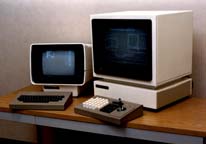
McAuto introduces the D-90 series of low cost design stations. This was a raster based system designed to replace the Tektronix storage-tube technology (note that it did not support either UniSolids or UniPCB). The initial model only had a black & white display, but the modular design provided a high degree of flexibility for customers and this layout was to become very popular as newer and higher performing terminals were introduced over the next several years. Also, the D-90 was a departure from the practice of integrating the hardware with a package that included free-standing furniture. Now that the terminal had been cut down to the bare essentials, McAuto was able to offer the initial models of the D-90 for the then unheard of price of only $17,500 each (remember, you still had to have a central CPU to hook the terminal to).DEC was the sponsor of the annual DEC Special Interest Group meeting held in Boxborough, MA. Note that this meeting had an expanded scope that included topics covering NC and Moldmaking as well as the traditional hardware themes. These gatherings were proving to be very popular with over 180 people in attendance at this latest meeting.
More then a year after that series of "Queen Mary" meetings that launched the largest development project yet in the history of the Unigraphics organization, McAuto announces Version 1.0 of Unigraphics II. From here on, the previous series of Unigraphics versions would always be known as Unigraphics I. As part of the marketing proposals it was decided that all future releases of Unigraphics II would only be identified by its version number with no special letter designation for any sort of sub-classification.September, 1983:In addition to a virtually complete re-architecting of the part data model (such as adding associative relationships), there were a large number of enhancements and new approaches to creating models and making drawings. Listed below are some of the major items:
Unigraphics II Version 1.0 was only available on 32-bit VAX and MV systems. And while there was limited support for the older Tektronix hardware, it was obvious that these devices were being phased out as supported terminals. Note that it would be several months before any customers actually put Unigraphics II into production but many "beta" sites were established and work went forward on fixing bugs and responding to the feedback from the early adopters.
- Unigraphics File Management (UGFM) system
- New View and Layout capabilities to support drafting
- Perspective views
- View Dependent editing
- General Part Merge as a replacement for Patterns
- User Defined Attributes
- Major improvements in Drafting functionality
- Dual Dimensioning
- Associative Dimensions, Labels, ID-Symbols and other annotation
- Class Selection Subfunction
- Grouping of Objects
- Major enhancements in CAM and GFEM
- First support for Sheet Metal operations
Version 1.1 of UniSolids is released. This version supported the Data General MV systems and also included many small, but quite useful enhancements (most of them dealing with the types of data that was transferred between UniSolids and Unigraphics). There were also enhancements aimed at improving performance as this was always a weakness which was typical of all CSG based systems of that era (models had to be regenerated from scratch upon opening the file and after even the most simple edit or change and since CPU's had very limited power at the time, this meant that only modest designs could be created with UniSolids).February, 1984:
The 8th Annual Unigraphics Users Meeting was held at the Marriott Hotel in Anaheim, CA.March, 1984:
McAuto releases Unigraphics I Version D5.0. While this was primarily a maintenance release there were minor enhancements to NC and plotting.May, 1984:
Two new versions of the McAuto design stations were released, the D-120C and D-120CE models. There were also "M" (for monochrome) class systems that had all of the same capabilities (except that its display was Black & White) as the "C" class systems. These were basically upgraded D-100's and were the last design stations sold that were packaged as free-standing furniture. The "E" models had extended graphics capabilities that supported local hardware dynamic rotation of wire frame images as well as support for panning and continuous zooming using the joystick controls. While these stations could still be used with Unigraphics I, many of the enhanced capabilities such as increased graphics memory, the local dynamics, gray scale control of the background, etc. were only supported with Unigraphics II.June, 1984:The D-120C systems had a list price of $48,000 and the D-120CE systems were sold for $53,000. Note that these systems could also have optional shader hardware added which allowed users to display shaded images of UniSolid models. These were static images and users had to perform a software rendering of a model and then the image would be automatically displayed with what was really a second graphics driver hooked to a common display screen. This was also the only way to create hidden-line images from a UniSolids model. Up until then, users had to purchase a special second terminal that was only used to show shaded images and they had to manually switch the input before they started the rendering operation.
July, 1984The Unigraphics development organization moves into their new offices at 5701 Katella Ave. in Cypress, CA. This was the first time that the west coast operation was housed in a "real" McDonnell Douglas corporate building (designated K34) and while it was a very large and well appointed facility there were a few problems that soon cropped up. Like on the first day in the new building when about half of the staff was refused access to the building by MDC security personnel because they were not properly attired (it seems that shorts and T-shirts were not part of the approved dress code for MDC employees). This caused a lot of fuss until executive management issued their famous "Summer Attire" memo that basically stated that employees could wear whatever they wished as long as it did not create a "safety hazard", which is the way it had to be worded to satisfy corporate security.
McAuto introduces the D-90C design station. This was basically the same configuration as a D-90 except that it had a color display and replaced the metal housing of the main display with a plastic shroud. The list price of a D-90C was $27,900.
The Unigraphics DEC Special Interest Group meeting was again held in Boston, MA thanks to the ongoing sponsorship by Digital Equipment Co.October, 1984:
McAuto introduces the D-2300 design station. While there were many people who thought that it looked like a "Microwave Oven" the D-2300 was one of the most sophisticated design stationsNovember, 1984:(display resolution was an amazing 3072 X 2304 pixels) ever developed for dedicated CAD/CAM usage. In addition to being an "all-in-one" configuration, it was also the first true 3D graphics device used with Unigraphics. It supported real-time local Pan/Zoom/Rotation in both wireframe and shaded mode (another first in the CAD industry). The user interface was a radical change from previous Unigraphics design stations in that a non-traditional layout PFK was incorporated, along with the normal keyboard, into a common configuration with a separate dial box that controlled the display. This was also the first design station that was not supported by Unigraphics I, however it did support Unigraphics II, UniSolids, UniPCB and Robotics (another first as up until then Robotics was only supported on Evans & Sutherland Picture System devices). The D-2300 was first demonstrated at AutoFact 6 held in Anaheim, CA.
V2.0 of UniSolids is released. In addition to many enhancements to the solid modeler itself, this version also allowed the user to import Unigraphics 2D profiles (consisting of arcs and lines) that could then be extruded into solid models.January, 1985:
McDonnell Douglas dropped the name McAuto from its automation group and created several different "companies" each with their own identity and name. The group that included the Unigraphics group was named CIMTECH, for Computer Integrated Manufacturing Technologies Company (over the next several years, the MDC organizations responsible for Unigraphics would have many different names).February, 1985: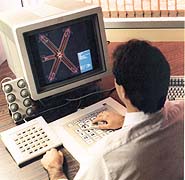
The new CIMTECH company announced that Unigraphics II was going to be offered for sale on IBM 4300 series mainframe CPU's and would fully support the new IBM 5080 display stations. The 5080's were similar to the D-2300's in that they supported local dynamic display (pan/zoom/rotate) control for both wireframe and shaded images (in fact Unigraphics was the first commercial product that supported these features on the 5080, well before software products such as Cadam and Catia, which were actually being marketed by IBM, supported them). Note that this was also the first time that Unigraphics supported a display station that did not use a separate message monitor. The Unigraphics menus were displayed in a small "window" superimposed on the graphics display (as shown at the right) in what turned out to be a precursor for what one day was to become the norm.
The 9th Annual Unigraphics Users Meeting was held at the Hyatt Regency Hotel in Long Beach, CA. The high point of the meeting was the private reception held at the "Spruce Goose" exhibition hall for nearly 450 attendees. One of the key topics of this meeting was the transition, or lack there of, of the user community from Unigraphics I to Unigraphics II. The product had been available for about a year and yet only a limited number of customers had yet gone into full production and so there were several presentations that covered the topic in some detail.March, 1985:
Introduced at this meeting were the new D-125 design stations. These were offered as replacements for the D-120 series however they were configured similar to the D-90 in that they were not a piece of furniture but rather separate display and message monitors. Also this marked the replacement of the metal enclosed keyboard and PFK with more modern looking plastic housings. The D-125 also marked the end of monochrome systems as it was only available with a color display, however it still included both a C and a CE version (the "C" designation was still used even though there was no monochrome version). The list prices for the C and CE versions were reduced to $43,000 and $48,000 respectively (but remember this did not include a table or furniture). These were also the last new design stations that would fully support Unigraphics I.
Version 2.1 of UniSolids is released. The major enhancements included the ability to create solids of revolution using a 2D profile of curves imported from Unigraphics as well as supporting hidden-line-removal as a display option (up until then, you could only get a HLR display as part of the static "rendered" image similar to shading).
Version 2.0 of Unigraphics II is finally released (almost a year and half after the introduction of Version 1.0). The vast majority of the effort was dedicated to improving both performance and reliability. Functional enhancements included the following:April, 1985:
- Mechanisms Module
- GSSM (Graphics Sequential Surface Machining) Module which introduced full APT like tool and surface containment capabilities
- Major enhancements to GSM
- Silhouette curves from analytic surfaces
- Enhanced Calculator functions
- Introduction of Customer Defaults as a user modifiable file (up until then, Customer Defaults were set using a program where users had to answer a long series of questions each time they wished to make even a single change)
- GRIP enhancements included support for mass property calculations and object attributes
June, 1985:McDonnell Douglas changes the CIMTECH name to MISCO (Manufacturing Industry Systems Company) and John Clancy was appointed President and George Meister relocated to St. Louis, MO where he assumed the role of vice president and General Manager of the CAD/CAM/CAE division. From this point forward, St. Louis would be the official "world headquarters" of the company despite the fact that Cypress remained the primary development and support location. We also got from this a new MDC marketing trust that included a new logo associated with the various computer related divisions including MISCO and Unigraphics.
By the middle of 1985, there were 377 companies using Unigraphics products around the world (up from just 56 customers in January, 1981) consisting of 601 systems (note that at that time, Unigraphics was still being licensed on a per system basis and not by the seat). Below are some charts showing the breakdown of Unigraphics products and the platform brands.July, 1985:
System Software UGI UGII Robotics (only) Total
Hardware Platforms DEC DG IBM A-100 Total
Systems With Additional Products UniSolids PCB Robotics
The D-2300 is finally ready to be sold to customers, however it would be October before any were actually delivered. While the D-2300 represented the leading edge display capabilities of the era, and even with its fully dynamic, ultra-high resolution shaded displays and integrated message monitors and PFK's, it was never a popular system due to many things, not the least of which was the price (in excess of $60,000) and a history of unreliable service (however, some were in fully production right up until the introduction of Unigraphics V10.0 which finally obsoleted them along with all other non-X-window displays).August, 1985:
The last full enhancement release of Unigraphics I was released, Version D6.0. Unigraphics I went into a maintenance only mode about 6 months later with only critical fixes being supplied in the form of software patches. However, since the software itself was still fully usable, as long as customers were able to maintain the hardware (CPU's and Design Stations) Unigraphics I saw continuous use well into the 1990's and since the actual UGI to UGII conversion software was being supplied with each release of Unigraphics II, many customers did not fully convert until many years later (who knows, there may be a few seats running out there still today).September, 1985:
What was now being called the DEC/NC/Moldmaking Special Interest Seminar was held at the Copley Plaza in Boston, MA and was again sponsored by Digital Equipment Co. (DEC). This marked the final migration of this meeting to a fall format. Nearly 350 people attended this meeting and it slowly took on the role of a major meeting, which in the years ahead provided an east coast opportunity for many users to attend a meeting closer to home then the annual trek to Southern California afforded them.October, 1985:
November, 1985:McDonnell Douglas forms a new software division called PC Productivity Systems. This organization was to develop a new PC based CAD system using the code for Unigraphics I as a starting point. A small team of people from the Unigraphics group were transferred to this company and it was set up as a totally separate entity (actually work had been under way since May, 1985 but this was the official announcement). The idea was to design a true 3D CAD/CAM product that could run on the PC's of the day. At the time only drafting systems were available on PC's and it was felt that someday that this growing segment of the industry might be important and so this effort was launched to gain an early foothold in this area.
Version 3.0 of UniSolids is released. In addition to improved performance and support of the D-2300, UniSolids 3.0 also provided support for a Torus primitive, tapered extruded solids and batch shading.
MISCO announces the release of V3.0 of Unigraphics II. In addition to many functional enhancements, there were also improvements to the display system (full support of the D-2300 including shaded displays as promised earlier) and the release of the UniPIX product.February, 1986:UniPIX was based on a product developed at Brigham Young University called BYU-Movie. This was an early attempt at providing high-quailty rendering of images from models created in Unigraphics. It worked on surfaced models (which included models imported from UniSolids) and provided both shading and hidden-line-removal output. This product was supported on all color design stations including the D-90C and the D-120/125CE as well as the D-2300 and IBM 5080 (the last two stations provided the best results of course due to the already very good support of color shading). The software was sold on a per seat basis for $2,000.
Also in November the first version of the GRIP International Library was released. This consisted of a collection of GRIP programs submitted by customers as well as many from technical people at Unigraphics. In the beginning the library was distributed on a 9-track tape and was provided to customers, for no charge, by request only. Later, after Unigraphics started to be distribute their products on CD-ROM, the GRIP International Library was included on the software CD so that all customers could get immediate access to the files whenever they needed them. The files are also available for download from the Unigraphics BBS.
The 10th Annual Unigraphics Users Meeting was held at the Hyatt Regency Hotel in Long Beach, CA. What a difference a year makes. The primary topic of this meeting was almost exclusively Unigraphics II with presentations from both customers and MISCO people. Topics covered was the upcoming version of Unigraphics II (V4.0) and new hardware, both CPU's and design stations. Also announced at this meeting was the fact that UniAPT was being moved to an unsupported status and that all maintenance fee's would be dropped to zero and that support would be very limited in the future (however, for at least the next decade or so, the Cypress technical support groups were helping people with UniAPT issues, even if it was all "unofficial"). Another topic discussed was the future requirements in the area of data management. Unigraphics II introduced the UGFM system which no sooner was it in place then it was seen as being unneeded. Standard file management systems were now all based on files & folders and there was no real need for a separate system from the native system. While it would be a couple of years before native file management was offered, this discussion laid the groundwork for both that effort and the larger needs of organizations that would lead to PDM systems of the future.March, 1986:
Version 3.1 of Unigraphics II is released. This is a maintenance only release.May, 1986:MISCO announces Unigraphics II ACCESS-50. This was a low cost seat of Unigraphics II that you installed on a central CPU but which you "accessed" (hence the name) from an IBM PC where there had been loaded software which emulates a Unigraphics II design station. This allowed a company to use lower cost PC hardware and still get most of the capabilities of a full seat of Unigraphics. Note that this was before the advent of MS-Windows and so this product included the GEM DESKTOP window system which allowed separate windows for graphics and the message monitor (note that this product actually benefited from some of the work that was being done at PC Productivity since they also chose to use the GEM DESKTOP window system). Later there was also an Apple Macintosh based version named ACCESS-150. Of course this version did not require any "desktop" emulator since the Mac already provided that environment.
MISCO announces the availability of the new D-135 design station as a replacement to the D-125C/CE. It was offered in only one configuration (hence the dropping of the "C" or "CE" designation) and provided improved graphics resolution, better overall performance due to the fact that it used a 19.2KB serial interface (until now all design stations, with the exception of the IBM 5080, were interfaced using a 9.6KB serial interface) and expanded graphics memory (1MB versus 192KB). This last feature was not enabled until the release of Unigraphics II Version 3.2 and until then operated basically as a D-125. Note that the D-135 was the last significant piece of hardware to carry a label with the Unigraphics name. From this point forward, all CPU's, displays and workstations were to carry the vendors name and and were sold with no modifications of any sort (the exception being the addition of an add-on PFK and in some cases, a separate message monitor).June, 1986:
PC Productivity Systems releases their first (and only) product, Crossroads. This was basically a PC version of Unigraphics I which provided the first full function 3D CAD/CAM system ever to be made available on an IBM PC. It used the GEM DESKTOP window system since MS-Windows had not yet been invented. Crossroads was many years ahead of its time, even to the point of implementing an Object Action based UI (User Interface), something that would not get introduced in Unigraphics until V16.0.July, 1986:Crossroads provided full 3D wireframe and surface modeling, drafting and mass properties (NC toolpath generation was to come later as an add on module). Since the part file data structure was identical to Unigraphics I, users could easily move files from Crossroads to Unigraphics II if they wished to. While the introduction of Crossroads caused a certain amount of excitement in the industry it never really took off. While the price of the software itself was was very reasonable at $2995 per seat (and this included the GEM software), it did require extensive upgrading to the PC including adding additional memory, a graphics card, a math-coproccesor and a large (in those days) 20mb hard drive (back then adding these items could easily double or triple the original cost of a basic PC). Crossroads was only on the market for about 3 years and while it can not be considered a commercial success, it did provide a preview of things to come (look at the picture of the display screen with its menu bar, pull down menu and "icons" to see how close it came to what we are all familiar with today) and many people continued to use the software for some time as it was truly the only 3D design system available on a PC for many years.
Version 3.2 of Unigraphics II is released. In addition to maintenance there were several enhancements, most of which had to do with supporting new hardware configurations. These enhancements included:August, 1986:
- New display architecture (needed because of the advent of "workstations).
- Support for the DEC VaxStation II/GPX the first true Unigraphics "workstation"
- Support for the full capabilities of the D-135 design station
- Support for the Tektronix D41XX terminal
The DEC VaxStation II/GPX was the first true workstation that was supported by Unigraphics (granted the ADS-100/A-100 was sold as a standalone unit and while it was sometimes referred to as a "workstation" it was really a traditional CPU, graphics monitor, message monitor, disk drive and archive storage all packaged into a single piece of furniture and sold as a dedicated unit). With the advent of these new workstations, the first thing that was dropped was the message monitor in favor of having the various pieces of data included in sub windows displayed on the main graphics screen. Note that while users could now select, using function keys and the numerical keypad, functions shown on a graphical PFK displayed on the main screen, many companies continued to purchase add-on optional PFK's from Unigraphics (some of the hardware vendors also sold optional PFK's of their own). To see what a VaxStation screen layout looked like, see the picture on the right.
The 1st Annual Japanese Unigraphics Users Meeting was held in Tokyo, Japan. The meeting was hosted by Seiko Instruments & Electronics. There were 38 users in attendance from 27 different companies.September, 1986:
The 4th Annual Special Interest Groups Meeting (this is the new name for the fall meeting) was held in Boston and was again sponsored by DEC.November, 1986:
Unigraphics II Version 4.0 is released. This was one of the most significant versions of Unigraphics II since the initial release in terms of new capabilities. Included in this release where things like:January, 1987:
- Assemblies & Components
- Parts List
- Machine Elements
- Interleaf interface
- Trimmed Surfaces (this was especially helpful when transferring models from UniSolids)
- Macro Tablets
- Major enhancements to GFEM and NC
The MDC division responsible for Unigraphics gets a new name, the McDonnell Douglas Manufacturing and Engineering Systems Company. John Clancy was named president of the M&E division.February, 1987:M&E (this is how the Unigraphics organization was generally referred to) announced that they would no long sell Data General hardware and that while they would still offer DG versions of Unigraphics II and UniSolids on an un-bundled basis, that this was only going to be for a limited time, probably not past the end of 1988.
The 11th Annual Unigraphics Users Meeting was held at the Anaheim Hilton & Towers in Anaheim, CA. The number one topic at the meeting was the announcement to drop Data General as a hardware vendor and the impending loss of support for Unigraphics users on DG hardware. This was such a big issue that the Unigraphics management was forced to make a commitment to continue full support of not only Unigraphics II, but also UniSolids and UniPCB. DG users would get enhancement releases for 5 years and full maintenance and support for 6 years. The only exception to this would be if a product was completely discontinued earlier than that (which is what happened, first with UniPCB and then with UniSolids). The agreement however did not guarantee that all new products or modules would be covered by this agreement, which was a continuous point of contention throughout the life of the agreement.March, 1987:Also announced at this meeting was the plans by M&E to add a license management system to Unigraphics II. This system, called the Access Control System (ACS) was to be introduced over time starting with Unigraphics II V4.1 where the Design/Drafting module would be managed and where additional products and modules would be added in later releases. This meant that all users would have to convert to per seat pricing and maintenance. Up until this time software was sold using several different schemes. On mainframes with multiple stations attached, Unigraphics was broken down into "Large" and "Small" system prices, based on the maximum number of terminals that could be hooked up and run at any one time, irrespective of whether there were actually that many present or not. On workstations and single display systems, the software was sold on a per seat basis, but there was no real way to stop a customer from running additional stations as a remote terminal. With the ACS scheme, really brought about because of things like VaxClusters running several VaxStations from a common server, each system would need to check-out a license before a module would be made available to a logged in user. While it did force some additional complexity for the customers, it did provide them with additional flexibility, and based on a very liberal grand-fathering plan, provided most of our users with many more seats of Unigraphics than they really needed and allowed them to either drop seats, which in many cases meant that they could reduce their monthly maintenance cost, or to delay the purchase of additional software due to the fact that they already had additional "licenses in the bank". This situation was on the mind of the Unigraphics people when years later there was the need to grand-father customers from V9.0 to V10.0.
April, 1987: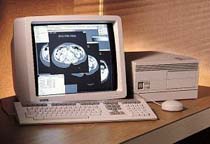
Version 4.1 of Unigraphics II is released. In addition to the introduction of the ACS system there were a large number of PR's addressed. Version 4.1 also supported the newly released DEC VaxStation 2000. This was a very compact unit and also was one of the first true desktop systems (note that the CPU, being housed in a case about the size of a large lunch box and having a fold away handle, made it very easy to carry and popular as a portable demo unit). The initial units were only available with a black & white display, but was soon followed by a color version. A typical VaxStation 2000 configuration is shown at the right.
During April the GM/EDS C4 LTD (Live Test and Demonstration) was performed in St. Louis, MO. This was basically a 2 day benchmark that reviewed virtually all of the capabilities of Unigraphics and all of it's modules. During the 2 days individual teams, made up of M&E, GM and EDS personnel, conducted approximately 50 different tasks. All of the major CAD/CAM vendors of the day participated in their own LTD's during this period. Based on this and other evaluations, the GM/EDS team intended to select a single "Strategic Partner" that would eventually provide GM with a single CAD/CAM system for their worldwide operations. Note that at the time of this evaluation, GM was using in production CAD software from 15 different vendors (including their own in-house developed CGS system), interestingly enough, Unigraphics was not one of the 15 (however, there were several significant installations of M&E's Robotic software installed at various GM production facilities). Pictured below is the team from M&E that participated in the 2 day LTD.June, 1987:
August, 1987: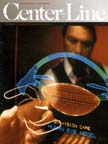
M&E publishes Volume 1, Number 1 of its new marketing magazine "CenterLine". This magazine, published on a regular basis, was intended to provide an opportunity to showcase the many successes that Unigraphics customers were having using the various products from M&E. The first issue included, along with an editorial from M&E President John Clancy, articles about Jacobsen (commercial lawn mowers), 3M (intraocular lenses), Oster (personal grooming), VME (excavating equipment), King Radio Corp. (flight instrumentation) and Hunt Machine & Manufacturing (mold tooling). There was also an interview with engineering personnel from the McDonnell Aircraft division of MDC about their utilization of CIM (Computer Integrated Manufacturing). If you would like to review other issues of the "CenterLine" magazine, please go to the Unigraphics "Archives".
September, 1987: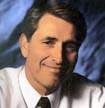
John Clancy retires from McDonnell Douglas and John Mazzola (shown at right) is appointed the new Executive Vice President of the Manufacturing & Engineering Systems Co. reporting to Jeremy Causley, Group Executive Officer, McDonnell Douglas Information Systems Group.
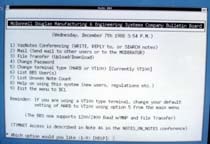
August also marked the launch of the Unigraphics BBS. This was probably the first BBS in the CAD industry. The open and uncensored (there were a few basic rules) nature of the Unigraphics BBS provided a forum for sharing ideas as well as creating a self help environment that is still being used today by users from all parts of the world. It also provided a means for direct communication between, not only the community of Unigraphics users, but also with the people working in the Unigraphics organization. For Unigraphics employees it is like meeting every day with their customers and being able to answer questions, help clarify concepts and on occasion, even ask the questions themselves to help them understand the issues and requirements of today's users in near realtime.
The 5th Annual Special Interest Groups Meeting was held in Cambridge, MA with over 300 people in attendance representing over 60 companies.October, 1987:
Unigraphics II Version 5.0 is released. Included in this release are new CAM modules which offer improved associatively. This release was also the first version of Unigraphics that supported NURB (Non-Uniform Rational B-spline) surfaces (b-surface). This was now the new standard mathematical form for complex geometry. Note that while the older parametric-cubic surface (AKA, "Gordon surface") were still fully supported, the new NURB form would eventually replace them.December, 1987:
Version 5.1 of Unigraphics II is released. This is primarily a maintenance release with several improvements in the Graphics Schematics Module (GSM).February, 1988:
The 12th Annual Unigraphics Users Meeting was held in Anaheim, CA. Over 550 people were in attendance. The highlight of the meeting was the introduction of Unigraphics support for the UNIX operating system. It was also announced at this meeting that Unigraphics was in the process of putting in place a single centralized customer support center that would provide direct phone support to all customers in the US and Canada. This would become known as the Technical Access Center (TAC).March, 1988:
June, 1988: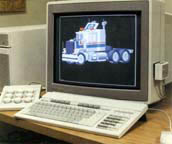
M&E formally rolls out Unigraphics running on UNIX workstations at both the NDE (National Design Engineering) Show in Chicago, IL and the NCGA (National Computer Graphics Association) Show in Anaheim, CA. The first UNIX workstations supported were the 300 series from Hewlett-Packard (shown at the right). Note that these workstations supported full 3D rotation of the
display using the optional dial box.On March 17th, St. Patrick's Day (which turned out to be somewhat significant), there was a meeting in Cypress attended by key Development and Marketing personnel that would prove to be one of the most important gatherings in the history of the company. It was at this meeting that a proposal was discussed about the need to produce a totally new product to replace Unigraphics. By this time it was generally acknowledged that a solid geometry based CAD system was highly desirable (remember this was before the acquisition of Shape Data) and that the company should begin to explore what it would take to accomplish that. Based on previous history, most people who walked into this meeting assumed that what we were really talking about was something that could be called UGIII however that did not sit well with the head of development, Bob Loss. It seems Bob had a strong aversion to naming this future product UGIII (you see at that time there was this feeling that products which carried a designation of "3" never quite turned out as well number "2" did, for example, look at how well the Apple III did). Anyway, Bob refused to let anyone use the word UGIII during the meeting since he was convinced that if we left the meeting with that name on our lips, that we would never be able to stop using it. So in order to avoid saying that "name" during the discussions that took place, the participants resorted to the use of a nonsense word, in this case "Kleenex Box" (there was one sitting in the middle of the conference room table) whenever they needed to say the "name" of the proposed new product. Well just before the meeting broke up someone commented that since it was St. Patrick's Day that maybe we could use that as inspiration. So this is how the "Shamrock Project" got its name.
Note however that while the Shamrock Project was originally intended to result in a totally new product, many factors became apparent over time which forced the company to slowly modify that vision to one where it was decided rather then pursuing a "revolutionary" process, that it would be more of a "radical evolution" of the existing Unigraphics II product. So while the original vision of that meeting was never realized, it started a series of events and activities that eventually lead to the development of Unigraphics V10.0. Remember that many forces were to come to play over the next several years, including the changing fortunes of McDonnell Douglas, the acquisition of Shape Data Ltd and the technology, as well as the ideas and vision of their people, that was now available, winning the GM business and the impact that their requirements suddenly had on the long term plans and then all of this coming to together with the sale of the Unigraphics organization to EDS in 1991. So in the end the impact of this meeting was akin to the proverbial stone dropped into the pond that started a ripple that eventually became a tidal wave.
However, there was one rather interesting legacy from that St. Patrick's Day meeting back in 1988. When the V10 project finally got into full swing, it was decided that as part of the marketing effort to position this product in the marketplace, that there would no longer be any use of the designation "Unigraphics II" in any company publication or marketing collateral.
M&E releases Version 5.2 of Unigraphics II. The primary purpose of this release was to provide support for the HP300 series of UNIX workstations.September, 1988:
The 6th Annual Special Interest Groups Meeting was held in Cambridge, MA.November, 1988:
December, 1988: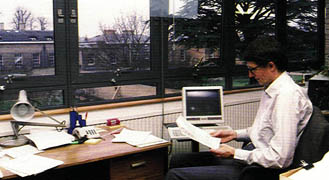
M&E completes the acquisition of Shape Data Ltd of Cambridge, UK. Shape Data was acquired from the Evans & Sutherland company and had been in business developing solid modeling software since 1974. The initial product released by Shape Data was Romulus in 1975. This was the first kernel solid modeler ever developed and was the forerunner to Parasolid. Shape Data also had marketed a commercial CAD system based on the Romulus kernel named Romulus-D. Shape Data's offices are located adjacent to historic Cambridge University and many of the employees are graduates of the university. The primary motivation for the acquisition was to gain access to Parasolid, a modern high performance B-rep solid modeling kernel. The decision to go the acquisition route was made after it became obvious that it was going to be impractical to adapt the C-rep PADL2 modeler (which UniSolids was based on) as the primary modeling core for the new product being proposed as part of the Shamrock Project.
Version 6.0 of Unigraphics II is released. This was a very significant release as there were many new capabilities including:February, 1989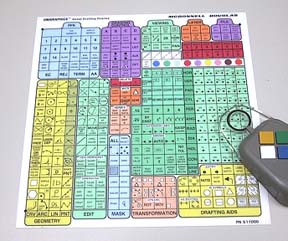
Perhaps the most significant aspect of Version 6.0 was the introduction of UG Detail Drafting. This was a lower cost version of Unigraphics aimed at those users who's primary task was creating engineering drawings, The idea was to have a simple-to-use drafting oriented version of Unigraphics packaged with additional features, such as a tablet interface (shown above) along with pre-programmed macros and GRIP programs that improved the productivity of creating drawings. While the core of the product was basically the same as standard Unigraphics, UGDD was sold without any add-on modules so things such as CAM and Surface Modeling was not available. This was a very successful product and many hundreds of copies were sold and was available as a fully supported product until the introduction of V10.0 when Unigraphics was restructured so that Drafting could be sold separate from Modeling and other modules.
- Hidden-Line-Removal (curve hiding curve)
- NURB curves (B-splines)
- Curvature analysis for curves and surfaces
- Deviation checking
- UG Detail Drafting (UGDD)
- Sheet Metal applications
- Cavity Milling
March, 1989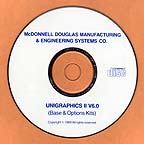
The 13th Annual International Unigraphics Users Meeting was held in Long Beach, CA. There were over 560 attendees including people from 7 European and Asian countries making this the most "international" meeting yet. Highlights of the meeting included an early look at the Parasolid based integrated solid modeling functionality that would be delivered with Version 7.0. Also at this meeting it was announced that starting with Version 6.0, customers would now have the option to receive Unigraphics on CD-ROM rather then magnetic tape (which was still the primary distribution media). 200 CD's for DEC VAX versions of V6.0 were produced at the last minute and handed out as sort of "souvenirs" to attendees (these CD's were ordered without even getting a test copy first, but the feeling was that it really didn't make any difference whether they worked or not since this exercise was seen by many as a gimmick, however it turned out that they worked just fine). There was also an announcement made that while paper based documents was still the only option available, that there were plans to switch over to CD-ROM based documentation sometime in the near future. Users were also encouraged to start upgrading their systems with CD-ROM drives and suggested that any new installations include at least one network accessible CD-ROM drive.
Version 6.0 of Unigraphics II is released on Apollo UNIX workstations.September, 1989
The 7th Annual Special Interest Group meeting was held in Cambridge, MA with over 300 people in attendance from 79 companies. This was to be the last of these meetings to be sponsored by DEC. While the meetings would continue to be held in the fall and on the East coast it was decided that the national user group would take over responsibility although DEC assured the executive committee that they would continue to provide what support that they could. However, the national group intended to change the format and that plans were already being formulated for the 1990 fall meeting. It was also announced at this meeting that all TAC phone lines were going to be consolidated into a single 800 number that would allow toll free access for all customers in the US and Canada.October, 1989
Version 6.0 of Unigraphics II is released on Sun UNIX workstations.November, 1989
The new single access number for the TAC center goes on-line. The new number, 1-800-955-0000, is still the main access number for today's GTAC (Global Technical Access Center).December, 1989
Version 7.0 of Unigraphics II is released. The most significant aspect of this release was the introduction of UG/Solids. This was a new module based on the Parasolid kernel modeler and was fully integrated into Unigraphics. Solid models created in UG/Solids could be added to a drawing and dimensioned the same as wireframe models. Also solids models could be machined using the normal CAM modules . Note that UG/Solids did not support parametric editing nor was there a sketcher, but models could be created by extruding/revolving a profile of curves. While UG /Solids was a new and extra cost module it was provided as a free upgrade to all UniSolid customers and there was a stand-alone program provided that could read the model graph of a UniSolids model and creates the equivalent Parasolid model in Unigraphics.
